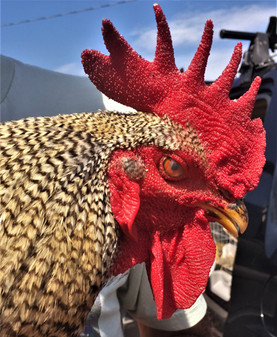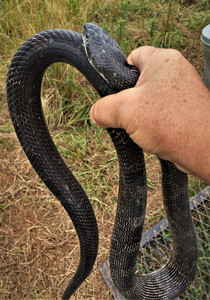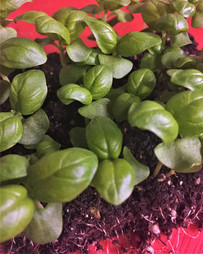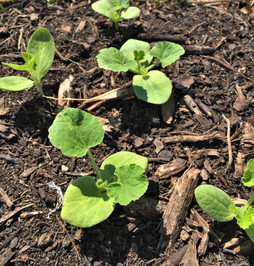June 10-16
- Rosa
- Jun 16, 2019
- 3 min read
Updated: Jun 19, 2019

Caring for the Chickens
This week we moved our chickens from the back fields to the top of the hill. Hunter hooked up the tractor and slowly hauled the coops with the chickens safely inside. The two flocks settled in quite happily to their new yards. An old oak and cherry tree lend them shade in the mornings and evenings.
Whenever a person walks by their fences, the chickens run up and squawk for treats. I brought them a mango and they tore it apart in seconds. The same with an over-ripe cucumber, which they seemed to enjoy for it's water content as much as anything. They love sunflower seeds and millet, too, but by far their favorite treat is dried mealworms. Even the shyest chicken, the ponderous Orpingtion, enters into the fray to get a beak-ful of bugs.
Welcoming New Chickens
Our flock has grown! We adopted 6 hens and a rooster from a friend. They're several breeds, including a tiny gray-gold bantam with a fluffy head. We placed them with our egg-laying flock. There were a few scrabbles, but the incoming chickens held their own, and in a few hours everyone seemed to content with the new pecking order.
The rooster is head-and-shoulders larger than any of our chickens. He patrols the yard as a peacemaker, stepping into fights and calming the hens. At night, he circles the yard until all the hens are roosted. He even scratches at the ground and then steps back to let the other chickens eat. He's quite cool-headed, and helped the new chickens settle in rather efficiently.
Though the flocks are happier and larger than ever, for the past week, our egg count has been down. We finally caught the culprit red-handed; a black snake feasting on the eggs.
Concetta grabbed it from the nesting boxes. It wasn't happy about the interruption, and even less happy to be put in a bag and carried deep into the woods. We moved the coops after it was relocated, so hopefully it won't find it's way back. Even if it does, we don't plan on killing it. Snakes are an important part of the ecosystem on our land, plus they're absolutely beautiful.
(If you don't wanna see a snake, skip the next two pictures.)
Blooming Bouquets
Our snapdragons have reached their peak. We filled a whole bucket with their blooms, and several more with the black-eyed Susans, lime-colored Queen Anne's lace, calendula, cosmos, and larkspurs. Since we harvest in the evenings, organizing the flowers is a night-time task, often with musical accompaniment.
Pollinator Frenzy
The return of the sun after a week of rain has sent the pollinators into a tizzy. Bees, beetles, and butterflies feast from the flowers. The butterflies seem partial to the bachelor buttons, while bees and small pollinators crowd onto the black-eyed Susans. The insects have plenty of blooms even after we harvest, and hopefully they make the short trip over to the vegetable garden to lend their services there.
Seedlings and Succession
Lillian and I moved what felt like 100 basil seedlings from their soil blocks into larger containers. After a few days outside, we planted them in the old potato beds. Every day, we transfer seedlings from soil to soil, setting in the waves of maturing plants to last through fall.
In the veggie garden, the pumpkin seeds are growing their second set of leaves, and the head-high corn is starting to bloom. The flower garden is greening with sunflowers and zinnias opening new leaves to the sun. We built three new beds on top of weed-suppressing cardboard, and then lay down a thick layer of hay. It'll decay and build a biome over winter, and be ready for future generations of blooms.
Harvests
The spring plants have finally relinquished the stage to the summer stars. We cleared several beds of spent plants, but luckily, some of them had time to set seeds before they crisped. I spent a few pleasant hours with our cat, collecting seeds from the honeyworts and the shelling peas.
We harvested a few servings of the first beets. Their brilliant red tops rise just out of the ground, so we could see the biggest ones. We also dug up the final potato bed, this time Yukon gold potatoes. For some reason these plants suffered far less beetle damage, so even though the bed was smaller, we harvested almost 30 pounds.
New crops are filling the spaces left behind by the firsts. The artichokes are forming prickly babies on the crowns of their stems, the cucumbers are laden with future pickles, and the banks of blackberries are speckled with ripened fruit.












































































Comments